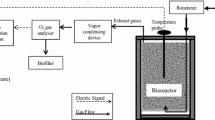Abstract
Transglutaminase catalyzes the cross-linking reaction between a glutamine residue and a free amine residue of proteins leading to the formation of protein aggregates. In this research, the effects of temperature, agitation, and aeration on the production of transglutaminase in a bench reactor by a newly isolated Streptomyces sp. from Brazilian soils were investigated using a factorial experimental design. The parameters evaluated influenced the enzyme production, and the data showed that the best conditions to enhance cell growth were different from those leading to enhanced transglutaminase production. Thus, a temperature and agitation shift strategy was adopted to increase transglutaminase productivity. The temperature and agitation were first set at 34 °C and 350 rpm, respectively, and after 24 h decreasing to 26 °C and 150 rpm until the end of fermentation. The transglutaminase activity obtained was 2.18 U/mL after 42 h of fermentation, which was twice than that obtained using a constant temperature and agitation fermentation strategy.



Similar content being viewed by others
Abbreviations
- TGase:
-
Transglutaminase
- DCW:
-
Dry cell weight
- TRS:
-
Total reducing sugars
- CBMAI:
-
Brazilian Collection of Environmental and Industrial Microorganisms
References
Zhang, D., Zhu, Y., & Chen, J. (2009). Biotechnology and Genetic Engineering Reviews, 26, 205–222.
Motoki, M., & Seguro, K. (1998). Trends in Food Science and Technology, 5, 204–210.
Yokoyama, K., Nio, N., & Kikuchi, Y. (2004). Applied Microbiology and Biotechnology, 64, 447–454.
Macedo, J. A., Fazani, A. L. C., Lopes da Cunha, R., & Sato, H. H. (2010). International Dairy Journal, 10, 673–679.
Dong, Z. J., Toure, A., Jia, C. S., Zhang, X. M., & Xu, S. Y. (2007). Journal of Microencapsulation, 24, 634–646.
Sung, K., Kamiya, N., Kawata, N., Kamiya, S., & Goto, M. (2010). Biotechnology Journal, 5, 456–462.
Giancone, T., Torrieri, E., Di Pierro, P., Mariniello, L., Moresi, M., Porta, R., & Mais, P. (2008). Journal of Food Engineering, 89, 195–203.
Zhu, Y., & Tramper, J. (2008). Trends in Biotechnology, 26, 559–565.
Josten, A., Meusel, M., Spener, F., & Haalck, L. (1999). Journal of Molecular Catalysis B: enzymatic, 7, 57–66.
Yan, G., Du, G., Li, Y., Chen, J., & Zhong, J. (2004). Process Biochemistry, 40, 963–968.
Ando, H., Adachi, M., Umeda, K., Matsuura, A., Nonaka, M., Uchio, R., Tanaka, H., & Motoki, M. (1989). Agricultural and Biological Chemistry, 53, 2613–2617.
Junqua, M., Duran, R., Gancet, C., & Goulas, P. (1997). Applied Microbiology and Biotechnology, 48, 730–734.
Pasternack, R., Dorsch, S., Otterbach, J., Robenek, I., Wolf, S., & Fuchsbauer, H. L. (1998). European Journal of Biochemistry, 257, 570–576.
Téllez-Luis, S. J., Ramírez, J. A., & Vázquez, M. (2004). Food Technology and Biotechnology, 42, 75–81.
Cui, L., Du, G., & Zhang, D. (2007). Food Chemistry, 105, 612–618.
Zhu, Y., Rizema, A., Tramper, J., & Bol, J. (1995). Applied Microbiology and Biotechnology, 44, 277–282.
Zhu, Y., Rizema, A., Tramper, J., Bol, J., & Bruin, E. (1998). Applied Microbiology and Biotechnology, 49, 251–257.
Zhu, Y., Rizema, A., Bonarius, H. P. J., Tramper, J., & Bol, J. (1998). Enzyme and Microbial Technology, 23, 216–226.
Portilla-Rivera, O. M., Téllez-Luis, S. J., Ramírez, J. A. L., & Vázquez, M. (2009). Food Technology and Biotechnology, 47, 19–26.
Soo-Hwan, Y., Jung-Hoon, Y., Lee, D. L., & Kim, H. S. (2009). Microbiology and Biotechnology, 19, 588–595.
Stanbury, P. F., Whitaker, A., & Hall, S. J. (2003). Principles of fermentation technology. Oxford: Butterworth Heinemann.
Macedo, J. A., Sette, L. D., & Sato, H. H. (2007). Electronic Journal of Biotechnology, 10, 618–626.
Folk, J. E., & Cole, P. W. (1966). Journal of Biological Chemistry, 241, 5518–5525.
Miller, G. L. (1959). Analytical Chemistry, 31, 426–428.
Hartree, E. F. (1972). Analytical Biochemistry, 48, 422–427.
Zheng, M., Du, G., Guo, W., & Chem, J. (2001). Process Biochemistry, 36, 525–530.
Acknowledgments
The authors would like to acknowledge the financial support received from Fundação de Amparo a Pesquisa do Estado de São Paulo and Conselho Nacional de Desenvolvimento Científico e Tecnológico.
Author information
Authors and Affiliations
Corresponding author
Rights and permissions
About this article
Cite this article
Bagagli, M.P., Sato, H.H. Two-Staged Temperature and Agitation Strategy for the Production of Transglutaminase from a Streptomyces sp. Isolated from Brazilian Soils. Appl Biochem Biotechnol 170, 1057–1065 (2013). https://doi.org/10.1007/s12010-013-0251-x
Received:
Accepted:
Published:
Issue Date:
DOI: https://doi.org/10.1007/s12010-013-0251-x




